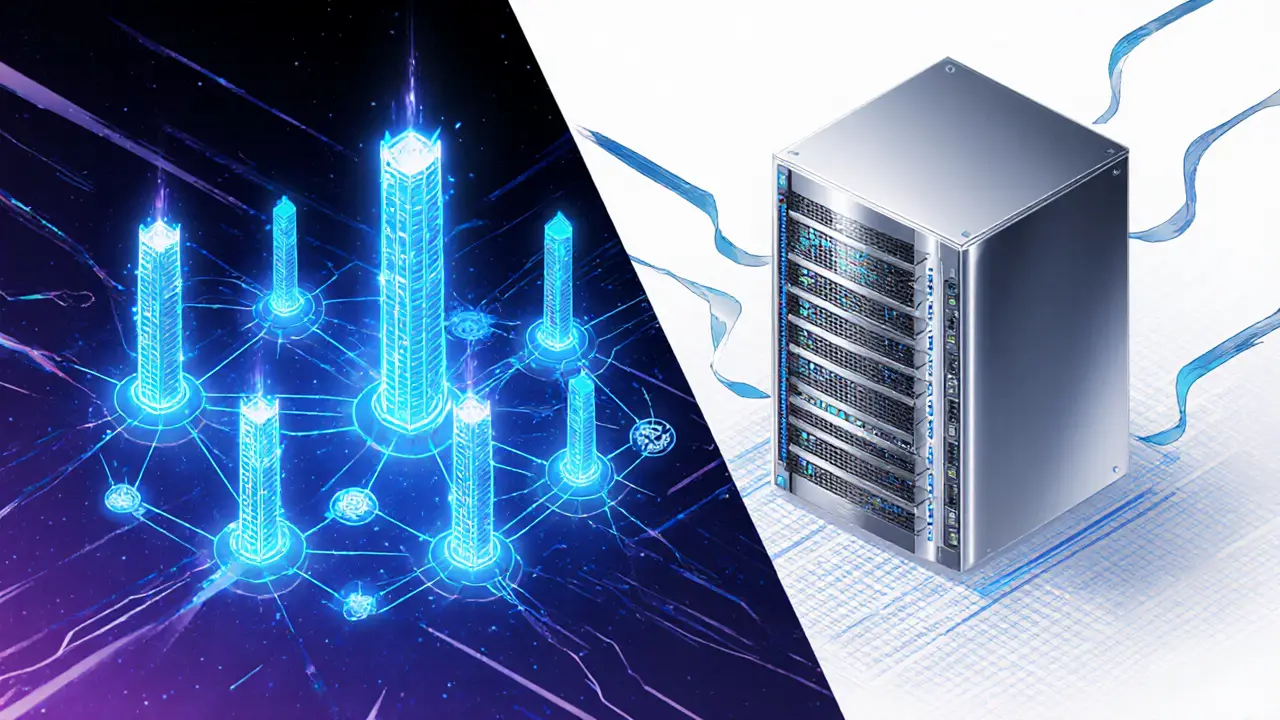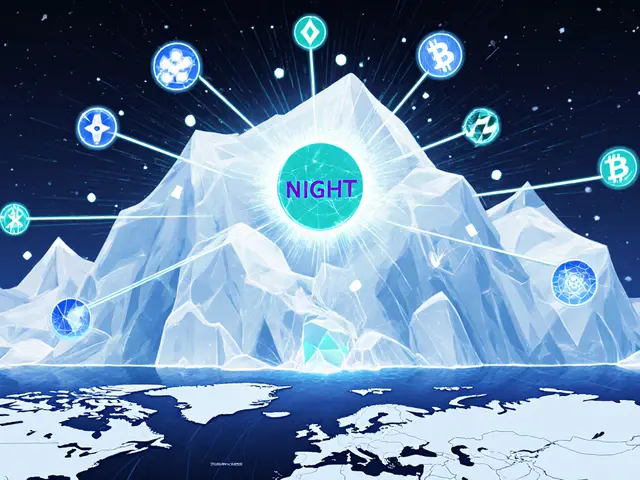Blockchain vs Traditional Database Decision Tool
Recommended Technology
When you hear the buzz about blockchain is a decentralized ledger technology that records transactions in an immutable chain of blocks, you might wonder how it stacks up against the tried‑and‑true traditional database is a centralized system that stores data in structured tables and supports CRUD operations. Both store data, both can be queried, but their core philosophies, performance, and costs differ dramatically. This guide walks you through the biggest contrasts, helps you spot the right tool for your project, and clears up the hype around the idea that blockchain will replace every database.
Core Architectural Differences
The first line that separates the two is decentralization is a design where control is spread across many independent nodes rather than a single authority versus centralization is a model where one entity or administrator manages data access and updates. In a traditional database, a DBA (database administrator) decides who can read or write. In a blockchain, every participating node validates each transaction, making trustless operation possible. This shift changes everything from fault tolerance to governance.
Data Structures and Storage Mechanisms
Traditional databases use predefined schemas-tables with rows and columns-so you can easily INSERT, UPDATE, or DELETE records. This flexibility is why relational databases dominate ERP, CRM, and analytics. By contrast, blockchain stores data in blocks is a sequential collection of transactions linked by cryptographic hashes. Once a block is sealed, its contents become immutable; you cannot alter or erase it without breaking the hash chain. The result is a complete, append‑only history-great for audit trails but cumbersome for frequent updates.
Performance and Scalability
If speed is king, traditional databases win hands down. Modern relational engines can process millions of queries per second, support complex joins, and deliver sub‑second response times. Blockchain, however, pays a price for security. Each transaction must be broadcast, validated by multiple nodes, and sealed into a block. That extra work limits throughput-public blockchains often handle under 100 transactions per second, while private setups might reach a few thousand at best. Latency can stretch from seconds to minutes, which matters if you need real‑time analytics.

Security Models
Traditional databases are vulnerable to a single point of failure: if the central server is compromised, the whole dataset can be exposed. You can mitigate risk with encryption, firewalls, and regular patches, but cryptography isn’t baked into the core architecture. Blockchain, on the other hand, embeds cryptography is a set of mathematical techniques that secure data and verify authenticity at every level. Each block contains a hash of the previous block, making tampering practically impossible without controlling a majority of the network-a scenario called a 51% attack, which is prohibitively expensive for most public chains.
Data Consistency and Integrity
In relational systems, the ACID properties-Atomicity is a all‑or‑nothing transaction guarantee, Consistency, Isolation, Durability-ensure that every transaction leaves the database in a valid state. Blockchains achieve consistency through consensus mechanisms is a protocol that nodes use to agree on the order and validity of transactions like Proof‑of‑Work or Proof‑of‑Stake. While both aim for integrity, blockchain’s approach is “everyone agrees” rather than “the central engine enforces”.
Cost and Resource Considerations
Running a traditional database usually means paying for a server or a cloud instance-costs scale linearly with storage and compute. Energy usage stays modest. Blockchain networks, especially those using Proof‑of‑Work, consume massive electricity because each node performs complex hashing. Even permissioned blockchains need multiple servers to host validator nodes, multiplying hardware expenses. If budget is tight, traditional databases are the safer bet unless you need the unique guarantees that only a blockchain can provide.
Ideal Use Cases
Think of a traditional database as the workhorse for applications that need frequent updates, complex queries, or real‑time reporting-think inventory management, financial accounting, or customer profiles. Blockchain shines when you need a shared, tamper‑proof record among parties that don’t fully trust each other. Classic examples include cryptocurrency transfers, supply‑chain provenance (tracking a product from raw material to shelf), digital identity verification, and decentralized voting.

Future Outlook and Hybrid Solutions
Most experts agree that blockchain won’t replace databases; instead, they’ll coexist. New “blockchain‑database hybrids” are emerging that add indexing, sharding, and off‑chain storage to boost performance while preserving immutability. Imagine a system where routine CRUD operations happen in a fast relational engine, and only critical audit events are written to a blockchain for permanent proof. This blend could give you the best of both worlds.
Quick Comparison Table
| Attribute | Blockchain | Traditional Database |
|---|---|---|
| Control Model | Decentralized (no single admin) | Centralized (DBA controls) |
| Data Mutability | Immutable; append‑only | Mutable; supports UPDATE/DELETE |
| Performance (TPS) | 10‑100 (public) / 1,000‑5,000 (private) | Millions per second |
| Security | Cryptographic hashes + consensus | Encryption, access controls |
| Cost | High compute & energy | Lower compute; pay‑as‑you‑go cloud |
| Typical Use Cases | Cryptocurrency, supply‑chain, identity | ERP, CRM, analytics, web apps |
Decision Checklist
- If you need fast, complex queries and frequent data modifications, go with a traditional database.
- If your project involves multiple independent parties that must share a single source of truth without trusting a central admin, consider blockchain.
- Budget constraints? Traditional databases usually win on cost.
- Regulatory compliance requiring immutable audit trails? Blockchain provides built‑in immutability.
- Can you tolerate a few minutes of latency for final transaction confirmation? That’s a blockchain characteristic.
Frequently Asked Questions
Can a blockchain replace my existing SQL database?
Not in most cases. SQL databases excel at high‑speed transactions, complex joins, and frequent updates. Blockchains add value when you need a tamper‑proof, shared ledger across untrusted parties. The usual pattern is to keep the SQL database for day‑to‑day operations and write critical events to a blockchain for auditability.
What’s the biggest performance bottleneck in blockchain?
The consensus process. Every node must validate each transaction and agree on the next block, which adds computational overhead and network latency. Proof‑of‑Work is especially heavy because of the hashing puzzles.
Is data stored on a blockchain publicly visible?
Public blockchains are transparent; anyone can read the ledger. Private or permissioned blockchains can restrict read access, so you can keep sensitive data confidential while still enjoying immutability.
How do ACID properties compare to blockchain consensus?
ACID guarantees happen inside a single database engine, ensuring every transaction is atomic and durable. Blockchain consensus achieves a similar goal-consistency-by having all nodes agree on the transaction order. However, blockchain sacrifices immediate durability for eventual finality, which can take seconds to minutes.
Are there hybrid solutions that combine both technologies?
Yes. Projects like BigchainDB and blockchain‑enabled PostgreSQL extensions let you store regular data in a relational engine while anchoring hash digests to a blockchain for tamper evidence. These hybrids aim to get the speed of databases with the trust guarantees of blockchains.








Monafo Janssen
October 8, 2025 AT 02:20Great overview! I like how you broke down the core differences in simple terms, making it easy for newcomers to follow. The comparison table is especially helpful for quick reference.
Michael Phillips
October 13, 2025 AT 23:27Reading through the architectural section made me reflect on how trust models shape technology choices. Decentralization indeed shifts responsibility from a single admin to collective consensus.
Jason Duke
October 19, 2025 AT 20:34Wow!!! This guide nails the hype vs reality debate-blockchain isn’t a magic bullet!!
Franceska Willis
October 25, 2025 AT 17:41Yo, love the colorful way you described the immutability thing-makes it feel like a rock‑solid vault.
Just a tiny typo: “permament” should be “permanent”.
Nicholas Kulick
October 31, 2025 AT 14:49When you’re picking a data store, start by asking how often you’ll write versus read. Traditional databases excel at high‑frequency writes and complex queries, so if your app does a lot of CRUD operations you’ll want the speed and indexing they provide. On the other hand, blockchains shine when many parties need to see the same record without fully trusting each other. The consensus layer guarantees that no single actor can rewrite history, which is essential for audit trails. Cost is another major factor; running a PoW blockchain can cost as much as a tiny data center in electricity alone. If your budget is tight, a relational engine on a cloud VM is usually cheaper. Security models differ too: DBAs lock down access with roles, while blockchains rely on cryptographic signatures and the hash chain. For regulatory compliance where an immutable log is mandated, a blockchain can reduce the need for separate logging solutions. Performance wise, expect latency of seconds to minutes on public chains, compared to sub‑second responses from a well‑tuned SQL server. Scalability can be addressed with sharding or off‑chain storage, but that adds complexity. Hybrid approaches are emerging: keep the day‑to‑day data in a fast DB and anchor critical hashes to a blockchain for proof of integrity. This gives you the best of both worlds, albeit at the cost of additional engineering effort. Finally, think about the skill set of your team; blockchains often require knowledge of smart contracts, consensus algorithms, and cryptography, while traditional databases are taught in most CS curricula. Weighing all these dimensions should help you land on the right tool for your specific use case.
Heather Zappella
November 6, 2025 AT 11:56This deep dive really clarifies the decision matrix. I’d add that the regulatory landscape is also evolving, especially around data privacy on public ledgers.
Jason Wuchenich
November 12, 2025 AT 09:03Exactly, and for teams new to consensus, starting with a permissioned setup can smooth the learning curve.
Kate O'Brien
November 18, 2025 AT 06:10Are you sure blockchains are safe? I hear they’re riddled with hidden backdoors and government spying.
Just kidding, but seriously keep an eye out.
Ricky Xibey
November 24, 2025 AT 03:17Nice summary.
Marcus Henderson
November 30, 2025 AT 00:25The formal tone of the explanation is appropriate for a technical audience. However, the lack of emojis may make the content appear less engaging to some readers.
Andrew Lin
December 5, 2025 AT 21:32Everyone forgets that blockchain is just a fancy hype machine designed by the elite to control our data! The energy waste is insane, and the “decentralization” promise is a myth.
Dawn van der Helm
December 11, 2025 AT 18:39🤔 While I get the excitement, let’s not ignore the environmental impact. 🌍 Maybe a hybrid solution can keep the best parts without the waste.